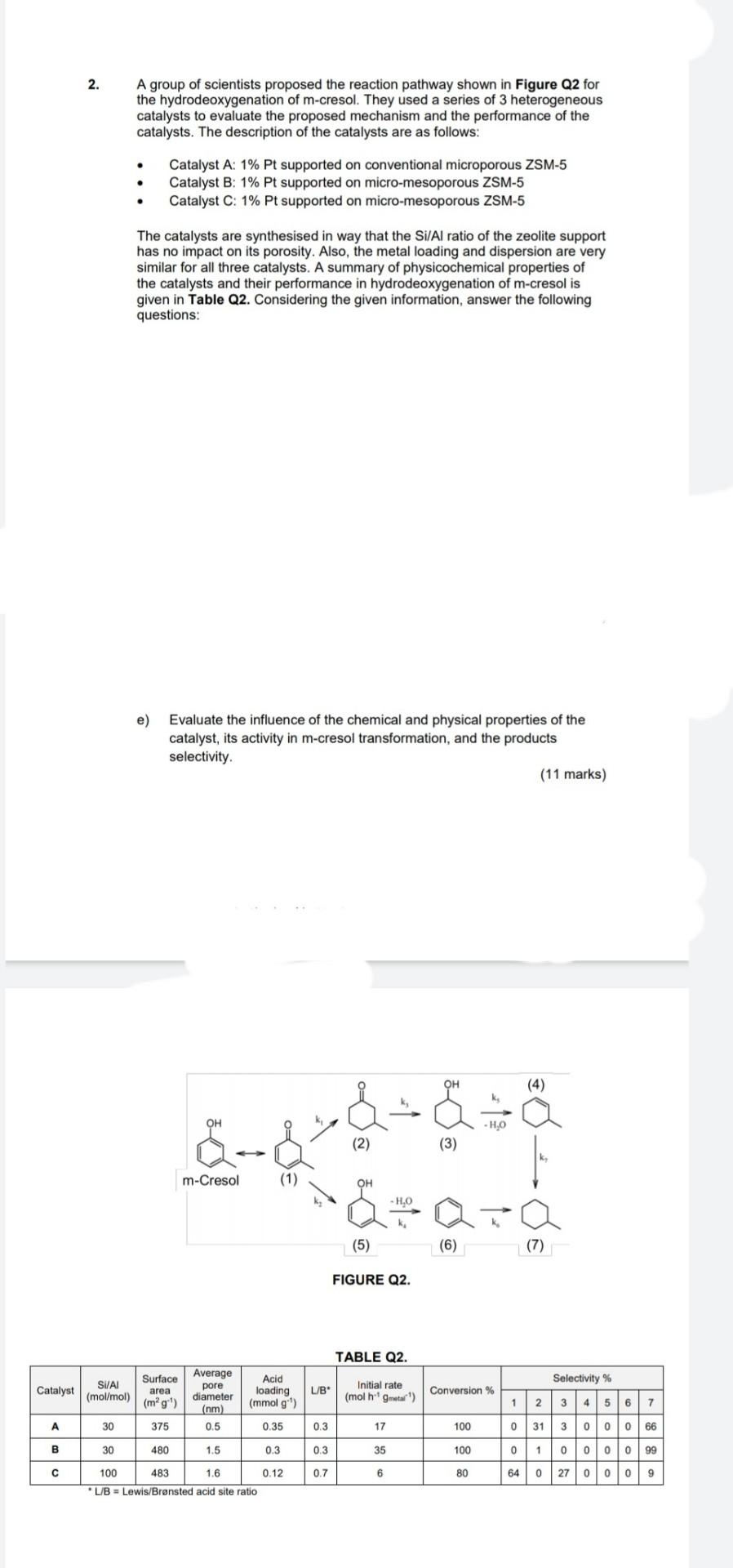Answered step by step
Verified Expert Solution
Question
1 Approved Answer
industrial catalysis 2. A group of scientists proposed the reaction pathway shown in Figure Q2 for the hydrodeoxygenation of m-cresol. They used a series of
industrial catalysis

2. A group of scientists proposed the reaction pathway shown in Figure Q2 for the hydrodeoxygenation of m-cresol. They used a series of 3 heterogeneous catalysts to evaluate the proposed mechanism and the performance of the catalysts. The description of the catalysts are as follows: Catalyst A: 1% Pt supported on conventional microporous ZSM-5 Catalyst B: 1% Pt supported on micro-mesoporous ZSM-5 Catalyst C: 1% Pt supported on micro-mesoporous ZSM-5 The catalysts are synthesised in way that the Si/Al ratio of the zeolite support has no impact on its porosity. Also, the metal loading and dispersion are very similar for all three catalysts. A summary of physicochemical properties of the catalysts and their performance in hydrodeoxygenation of m-cresol is given in Table Q2. Considering the given information, answer the following questions: e) Evaluate the influence of the chemical and physical properties of the catalyst, its activity in m-cresol transformation, and the products selectivity. (11 marks) OH (4) OH - H,0 V > (2) (3) sode m-Cresol OH - H.O (5) (6) FIGURE Q2. TABLE Q2. Catalyst (mol/mol) SI/AI Surface area (mg) Average pore diameter (nm) Acid loading (mmol g') L/B Initial rate (mol h metal) Conversion % A 30 375 0.5 0.35 0.3 17 100 Selectivity % 1 2 3 4 5 6 7 0 31 3 0 0 0 66 0 1 0 0 0 0 99 640 270009 B 30 480 1.5 0.3 0.3 35 100 0.7 6 80 100 483 1.6 0.12 *L/B = Lewis/Brnsted acid site ratio 2. A group of scientists proposed the reaction pathway shown in Figure Q2 for the hydrodeoxygenation of m-cresol. They used a series of 3 heterogeneous catalysts to evaluate the proposed mechanism and the performance of the catalysts. The description of the catalysts are as follows: Catalyst A: 1% Pt supported on conventional microporous ZSM-5 Catalyst B: 1% Pt supported on micro-mesoporous ZSM-5 Catalyst C: 1% Pt supported on micro-mesoporous ZSM-5 The catalysts are synthesised in way that the Si/Al ratio of the zeolite support has no impact on its porosity. Also, the metal loading and dispersion are very similar for all three catalysts. A summary of physicochemical properties of the catalysts and their performance in hydrodeoxygenation of m-cresol is given in Table Q2. Considering the given information, answer the following questions: e) Evaluate the influence of the chemical and physical properties of the catalyst, its activity in m-cresol transformation, and the products selectivity. (11 marks) OH (4) OH - H,0 V > (2) (3) sode m-Cresol OH - H.O (5) (6) FIGURE Q2. TABLE Q2. Catalyst (mol/mol) SI/AI Surface area (mg) Average pore diameter (nm) Acid loading (mmol g') L/B Initial rate (mol h metal) Conversion % A 30 375 0.5 0.35 0.3 17 100 Selectivity % 1 2 3 4 5 6 7 0 31 3 0 0 0 66 0 1 0 0 0 0 99 640 270009 B 30 480 1.5 0.3 0.3 35 100 0.7 6 80 100 483 1.6 0.12 *L/B = Lewis/Brnsted acid site ratio
Step by Step Solution
There are 3 Steps involved in it
Step: 1

Get Instant Access to Expert-Tailored Solutions
See step-by-step solutions with expert insights and AI powered tools for academic success
Step: 2

Step: 3

Ace Your Homework with AI
Get the answers you need in no time with our AI-driven, step-by-step assistance
Get Started


